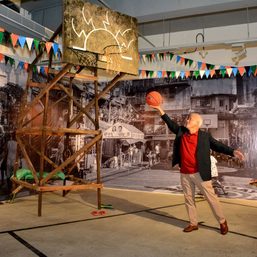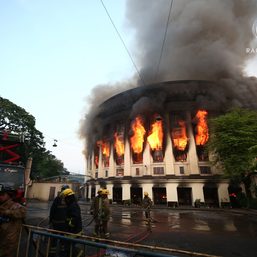SUMMARY
This is AI generated summarization, which may have errors. For context, always refer to the full article.
![[Ilonggo Notes] Taking a heritage walk along Roxas City](https://www.rappler.com/tachyon/2024/06/provincial-capitol2.jpg)
Roxas City, the capital of Capiz, is undergoing a major building and development boom, with improvements in the Culasi port (gateways to Northern Panay, Romblon, Lucena, and Batangas).
New resorts and restaurants along the beachfront (Baybay), construction of malls, inter-provincial bus terminals, and the “city within a city” development, a township called Pueblo de Panay, where Capiz’s first multi-story condos and office buildings are located.
Just about two hours from Iloilo; it was so named in 1951, after its most illustrious son, former president Manuel Roxas. Capiz is a Hispanicized word for kapis, palm-sized bivalves with translucent shells much favored for window panes, lanterns, chandeliers, wind chimes, and other art objects. Ilonggo (Hiligaynon) is also widely spoken here.
A fascinating, (and often condescending and patronizing) description of life in Capiz, Filipinos, and the public schools in the first decade of the 20th century was written by a Thomasite teacher, Mary H. Fee, in A Woman’s Impressions in the Philippines (1910).
Fee wrote: “…that first impression was the one of greatest charm, and the one I love best to remember. There were the great, square, white-painted, red-tiled houses lining both banks of the river; the picturesque groups beating their clothes on the flat steps that led down to the water; and the sprawling wooden bridge in the distance where the stream made an abrupt sweep to the right.”
“On the left of the bridge was a grassy plaza shaded with almond trees, a stately church, several squat stone buildings which I knew for jail and municipal quarters, and a flagstaff with the Stars and Stripes whipping the breeze from its top. Overall hung a sky dazzlingly blue and an atmosphere crystal clear. Back of the town, a low unforested mountain heaved a grassy shoulder above the palms, and far off there was a violet tracery of more mountains. I knew that I should like Capiz.”

Sights, sounds, landmarks
For many people from neighboring Iloilo, Capiz is only a transit point to Boracay and Kalibo for the Ati-Atihan festival, or jokingly associated with the aswang. Many are unaware that the province has a rich and fascinating culture and history, or that Aklan was carved out of Capiz only in 1956.
It is the old center of Roxas city I like the most. In this area roughly the size of four city blocks, heritage structures abound – the centuries-old capitol, bridge, the plaza, cathedral, monuments, and a museum. Around this little center, residences from the 1950s and 1960s give one the feel of a laid-back, sedate town. It is rare to find buildings over four stories.
A route for the walk can start anywhere. One way is to start right at the fountain, which is kilometer zero for Capiz – all distances over the province are measured from here. The fountain has undergone several renovations in the past and its current form hearkens back to the original design. It will be a full century-old in 2025.
If you turn to your right facing the church, the Rizal monument – one of the oldest in the country, built in 1911, is right in front of the provincial capitol, a solid-looking, unadorned building designed by William Parsons.

Jesuit historian Rene Javellana says of the capitol, “style is inspired by the California missions…. elements of Classical architecture are evident in the central portal, and the generous use of Roman arches for windows; it lacks the temple-like look of Neo classical capitols and municipal hall…a modern and simplified interpretation of Spanish-Filipino architecture of the 19th century.”
An eagle – a nod to the Americans – a is sculpted above the main entrance to the building on top of the provincial seal.
Across the street, the major landmark is the aathedral, dedicated to the Immaculate Conception. Originally from the 1870s, it was reconstructed in the 1950s after being damaged by war, storms, and earthquakes. The ceiling paintings and altars have been restored to their original glory, while on the right side near the entrance, there is an informative history of Catholicism in the province.

From the church and the neoclassic-style city hall beside it, one can cross the street to walk over to the little plaza with two ornately designed heritage structures, both octagonal. One has been enclosed and also serves as a tourist information center. I would have wanted to see the interior but it was closed early in the morning. The other one, an open-sided gazebo and bandstand, was built in 1926 under the auspices of the city’s premier social club, Circulo Galante. Inscriptions in Spanish around the gazebo feature names of the Capiceño elite and members of the Circulo.
Local historian Christian Acevedo writes that the bandstand served as the center of town life, where many fiesta queens were crowned, and still serves as a venue for community activities. It was designed by local architect Jose Roldan.

From here one overlooks the sturdy-looking Roxas city bridge, which traverses the Pan-ay river, the longest river in the province. This bridge connects to the main highways as well as to the commercial district of the city, and on to the Pueblo de Panay. On both sides of the bridge, pedestrian pathways offer a view of the relatively clean river and embankments. A riverside esplanade is being constructed on the side of the plaza and church.

Walk along Washington Street, the riverside embankment beside the plaza. away from the bridge, for about three minutes, and you’ll stumble upon a trio of old houses, done in the bahay-na-bato style, but a bit haphazardly refurbished. One has been completely demolished, a former balcony atop the house entrance remaining but overgrown with foliage. These three, near the corner of Washington and Aglipay streets, all have Katipunan symbols on their front, indicating these were houses of Katipuneros or their supporters.
The street names reflect the Capiceños desire for independence. Gregorio Aglipay’s nationalistic, anti-friar, and anti-Catholic stance (though he was a former Roman Catholic priest) led to the founding of the Philippine Independent Church and the Aglipayan religion. From here you can turn back and walk along a side street to reach the Acuña ancestral home, where the most illustrious son of Capiz, Manuel Acuña Roxas, was born in 1892, a few months after his father, Gerardo was killed.

Brought up by his mother and grandparents, Roxas had a brilliant academic and political career (bar topnotcher, former governor, speaker of the House of Representatives, Senate president, secretary of finance, head of the Philippine delegation negotiating for Independence from the US, Constitutional
Convention delegate).
This culminated in his election as the last President of the Philippine Commonwealth and the first president of the Philippine Republic (1945-1948). In an iconic photo, he is raising the Philippine flag for the first time, as the last US Resident commissioner, Paul McNutt, lowers the American flag. Less than two years into his presidency, he had a massive heart attack and died.
This house is reputed to be the oldest surviving bahay na bato in Capiz; there is a historical plaque in front. It is well maintained and contains period furniture, fixtures, and family memorabilia, including documents written by a high-ranking official of the Japanese army, Colonel Nobuhiko, who managed to save Roxas from execution; the house is now managed by the Albar family, who are relatives of the former president. Former senator, trade secretary, and presidential candidate Mar Roxas is a grandson.
Exiting the house, walk back towards the church and you will see the bronze Roxas monument in the plaza, a replica of a Guillermo Tolentino sculpture. Beside it is the Panublion (inheritance) museum, set in a huge circular structure that was originally built as a water tank in 1916. The cozy, compact museum has a reading room/library and displays on, the history of Capiz, two female national artists from Capiz – Jovita Fuentes for music and Daisy Hontiveros Avellana for theater.

Other displays include the Panay Bukidnon (IP) culture and traditions – “Panubok” embroidery, using patterns derived from nature, such as ferns and birds; and traditional weapons like blowguns, talibongs, agricultural tools, and implements.
In May and June 2024, two special exhibits include contemporary works on the theme of “Away Dunggan” (Inner Struggles) and a commemoration of the inauguration of the Republic in 1946. Landscape architect Paulo Alcazaren considers the Roxas city plaza “lovely and defined by (at least) eight examples of conserved heritage, more than what your average plaza might have.” Nowadays, the church, fountain, and several landmarks are attractively lit and perfect for an evening stroll. The first ordinance of Mayor Ronnie Dadivas, elected in 2019, was to declare the plaza a heritage zone.
Nearby attractions
If one has an extra hour, just 2.5 kilometers away is the church of Sta. Monica in Pan-ay, which has the biggest bell in Asia. Seventy sacks of coins were melted to cast it. It measures over two meters in diameter, 1.5 meters in height, and weighs over 10 tons, and can be heard over an eight-kilometer distance.
Pan-ay is one of the oldest settlements in the country, a pre-colonial trading hub, and later lent its name to the whole island of Panay. Capiz also enjoys the reputation of being the seafood capital of the country, and like Aklan, is said to also supply many of Iloilo’s restaurants. Barangay Banica is famous for its dried fish market.
From the 1850s to the 1910s, Capiz was the biggest producer of nipa palms and was also known for making wines from nipa. One of the earliest entrepreneurs was Margarita Roxas; her nephew, Antonio, was the paternal grandfather of future president Manuel. However, during the early American era, prohibitionists managed to get alcohol-producing facilities closed, striking a blow to the local economy.
Nevertheless, there are still native delicacies such as the basa-basa, a little dollop of sticky rice, cooked in nipa wine. Other Capiznon rice-based sweets include puso or sticky rice, and biko, a type of suman. Panulce is a popular cake and pastry shop just behind the capitol, while a Roxas city bakeshop and restaurant, “Bread Basket” has now expanded to Iloilo. – Rappler.com
With thanks to Cheryl Anne Del Rosario, Director, Ang Panublion Museum for additional information.
Add a comment
How does this make you feel?










![[OPINION] Dipolog City: Is it modernization or cultural revision that’s happening?](https://www.rappler.com/tachyon/2024/07/dipolog-feature-july-6-2024.jpg?resize=257%2C257&crop=0px%2C0px%2C720px%2C720px)
![[Time Trowel] Yamashita gold is a myth, and treasure hunting is not archeology](https://www.rappler.com/tachyon/2024/06/myth-yamashita-treasure-june-14-2024.jpg?resize=257%2C257&crop=435px%2C0px%2C1080px%2C1080px)
![[Time Trowel] Safeguarding the Ifugao Rice Terraces for future generations](https://www.rappler.com/tachyon/2024/05/batad-rice-terraces-may-25-2024.jpg?resize=257%2C257&crop_strategy=attention)
There are no comments yet. Add your comment to start the conversation.